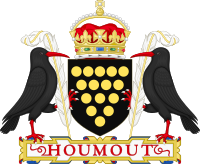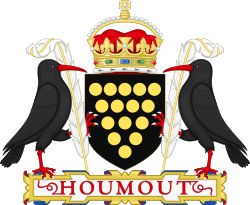Duke of Cornwall facts for kids
Quick facts for kids Dukedom of Cornwall |
|
|---|---|

|
|
| Creation date |
|
| Monarch |
|
| Peerage | Peerage of England |
| First holder | Edward of Woodstock |
| Present holder | William, Prince of Wales |
| Extinction date |
|
| Former seat(s) | Restormel Castle |
| Motto | German: Houmout ("High-spirited") |
The Duke of Cornwall is a special title in England. It is usually held by the oldest son of the British monarch. This means the person who is next in line to become king or queen.
The Duchy of Cornwall was the very first dukedom (a land ruled by a duke) created in England. It was set up by a special rule in 1337. Today, Prince William is the Duke of Cornwall. He became duke when his father, King Charles III, became king in 2022. Prince William's wife, Catherine, is known as the Duchess of Cornwall.
Contents
Ancient Stories of Cornwall
Some old stories from the British Isles talk about the first leaders of Cornwall. One famous story is from a book called History of the Kings of Britain (written in 1136). It says that a warrior named Corineus was the first leader of Cornwall. He was an ally of Brutus of Troy, who was said to be the first settler of Britain.
In these tales, the legendary dukes of Cornwall were powerful. They were close friends and sometimes protectors of the high-king of Britain. One story tells of Gorlois, the Duke of Cornwall. He rebelled against King Uther Pendragon. King Uther wanted Gorlois's wife, Igraine. Uther killed Gorlois and married Igraine. Their son was the famous King Arthur. These are just old stories, not real history.
A Look Back in Time
History shows that Cornwall was once part of a separate kingdom called Dumnonia. This kingdom also included Devon. Sometimes, Cornwall even had its own rulers. Over time, the Germanic people who formed the Kingdom of England took over the Celtic southwest of Britain.
After the Norman Conquest in 1066, new English rulers appointed their own people to lead Cornwall. These leaders were called "earls of Cornwall." The very first earl was actually from Brittany, a region in France.
Edward of Woodstock was the oldest son of King Edward III. In 1337, he became the first Duke of Cornwall. This happened after his father lost the title of Duke of Normandy. Cornwall was the first dukedom ever given out in the Kingdom of England.
Who Becomes Duke?
A special rule was made in 1337 about who would be the Duke of Cornwall. It said that the duke would always be the oldest son and heir of the monarch. An "heir apparent" is the person who is definitely going to inherit the throne.
Sometimes, this rule was not followed exactly. But in 1606, a legal case decided that the rule must always be followed.
If there is no duke, the monarch (the king or queen) becomes the owner of the Duchy of Cornwall. Even if a former duke had children, his grandson cannot become duke. Only the monarch's own son can. Also, a female can never be the Duke of Cornwall. Even if she is next in line to the throne, she cannot hold this specific title. However, if a queen has no son, she would manage the Duchy herself.
If a Duke of Cornwall dies without children, his next brother becomes the duke. This is only if that brother is also the oldest living son and heir to the throne.
It's possible for someone to be Prince of Wales without being Duke of Cornwall. The title 'Prince of Wales' is given to the heir to the throne by the monarch. It is not automatically given only to the oldest son.
For example, after Frederick, Prince of Wales died, his son George became the heir to King George II. Young Prince George was made Prince of Wales. But he did not become Duke of Cornwall because he was the king's grandson, not his son. When the monarch has no son, the Duchy of Cornwall goes back to the Crown. It stays with the Crown until a new son is born or a new monarch with a son takes the throne.
James Francis Edward Stuart was born Duke of Cornwall in 1688. His father, James II, lost the throne. But James Francis Edward kept his titles. Later, he claimed his father's lost thrones. Because of this, he was accused of treason in 1702. So, his titles were taken away under English law.
What the Duke Does
The Duchy of Cornwall owns a lot of land. It has over 220 square miles (570 square kilometers) of land. More than half of this land is in Devon. The Duke has certain rights over the land in Cornwall.
For example, the High Sheriff of Cornwall is chosen by the duke, not the monarch. This is different from other counties in England and Wales. The duke also has the right to take the property of anyone in Cornwall who dies without leaving a will or known family. This is called bona vacantia.
In 2013, the Duchy had a lot of extra money, about £19 million. This money was not taxed. But Prince Charles, who was the duke at the time, chose to pay tax on it anyway.
Before 2011, if there was no Duke of Cornwall, the money from the Duchy went to the Crown. Now, under a law passed in 2011, the money from the Duchy of Cornwall goes to the heir to the throne. This happens even if they are not officially the Duke of Cornwall. If the heir is a child, 10% of the money goes to them. The rest goes to the Crown.
The Duke's Coat of Arms
The coat of arms for the Duke of Cornwall is black with fifteen golden discs. These golden discs are called "bezants." This design is now used as a badge by the Prince of Wales. It appears below the shield on his coat of arms.
The arms were first used in the late 1400s. They were based on the arms of Richard, Earl of Cornwall. The bezants in Richard's arms were meant to look like peas. This was a playful reference to the French region of Poitou, where he was a count.
In 1968, a special royal order added the heir apparent's coronet to the arms. A coronet is a small crown. This coronet has four crosses and four lily shapes. The animals supporting the shield are two Cornish choughs. Each chough holds an ostrich feather. The motto used with the arms is Houmout. This means "High-spirited" in an old German language. It was the personal motto of the Black Prince.
 |
|
Dukes of Cornwall (1337 Creation)
Most Dukes of Cornwall have been the oldest living son of the monarch. They are all considered part of the same original creation of the dukedom. Here are some of the Dukes of Cornwall:
Other Dukes of Cornwall
Sometimes, the title of Duke of Cornwall was created in different ways.
1376 Creation
When Edward the Black Prince died before his father, King Edward III, the king gave the title 'Duke of Cornwall' to his grandson, Richard of Bordeaux. When Richard became King Richard II in 1377, this special creation of the title ended.
- Richard of Bordeaux (1367–1400)
- also Prince of Wales (1376)
1460 Creation
Richard Plantagenet wanted to become king. So, he was made heir to King Henry VI. On October 31, 1460, he was made Prince of Wales and Duke of Cornwall. He was not the king's oldest son, so this was a special creation. Richard died in battle two months later.
- Richard Plantagenet (1411–1460)
- also Prince of Wales (1460)
The Jacobite Duke
Charles Edward Stuart was the oldest son of James Francis Edward Stuart. He was born in Rome in 1720. Soon after his birth, he was declared Prince of Wales and Duke of Cornwall by those who supported his family's claim to the throne (called Jacobites). When his father died in 1766, Charles Edward claimed to be King of England. He died in 1788.
Family Tree
| Princes of Wales, Dukes of Cornwall, and Dukes of Rothesay family tree | |||||||||||||||||||||||||||||||||||||||||||||||||||||||||||||||||||||||||||||||||||||||||||||||||||||||||||||||||||||||||||||||||||||||||||||||||||||||||||||||||||||||||||||||||||||||||||||||||||||||||||||||||||||||||||||||||||||||||||||||||||||||||||||||||||||||||||||||||||||||||||||||||||||||||||||||||||||||||||||||||||||||||||||||||||||||||||||||||||||||||||||||||||||||||||||||||||||||||||||||||||||||||||||||||||||||||||||||||||||||||||||||||||||||||||||||||||||||||||||||||||||||||||||||||||||||||||||||||||||||||||||||||||||||||||||||||||||||||||||||||||||||||||||||||||||||||||||||||||||||||||||||||||||||||||||||||||||||||||||||||||||||||||||||||||||||||||||||||||||||||||||||||||||||||||||||||||||||||||||||||||||||||||||||||||||||||||||||||||||||||||||||||||||||||||||||||||||||||||||||||||||||||||||||||||||||||||||||||||||||||||||||||||||||||||||||||||||||||||||||||||||||||||||||||||||||||||||||||||||||||||||||||||||||||||||||||||||||||||||||||||||||||||||||||||||||||||||||||||||||
|---|---|---|---|---|---|---|---|---|---|---|---|---|---|---|---|---|---|---|---|---|---|---|---|---|---|---|---|---|---|---|---|---|---|---|---|---|---|---|---|---|---|---|---|---|---|---|---|---|---|---|---|---|---|---|---|---|---|---|---|---|---|---|---|---|---|---|---|---|---|---|---|---|---|---|---|---|---|---|---|---|---|---|---|---|---|---|---|---|---|---|---|---|---|---|---|---|---|---|---|---|---|---|---|---|---|---|---|---|---|---|---|---|---|---|---|---|---|---|---|---|---|---|---|---|---|---|---|---|---|---|---|---|---|---|---|---|---|---|---|---|---|---|---|---|---|---|---|---|---|---|---|---|---|---|---|---|---|---|---|---|---|---|---|---|---|---|---|---|---|---|---|---|---|---|---|---|---|---|---|---|---|---|---|---|---|---|---|---|---|---|---|---|---|---|---|---|---|---|---|---|---|---|---|---|---|---|---|---|---|---|---|---|---|---|---|---|---|---|---|---|---|---|---|---|---|---|---|---|---|---|---|---|---|---|---|---|---|---|---|---|---|---|---|---|---|---|---|---|---|---|---|---|---|---|---|---|---|---|---|---|---|---|---|---|---|---|---|---|---|---|---|---|---|---|---|---|---|---|---|---|---|---|---|---|---|---|---|---|---|---|---|---|---|---|---|---|---|---|---|---|---|---|---|---|---|---|---|---|---|---|---|---|---|---|---|---|---|---|---|---|---|---|---|---|---|---|---|---|---|---|---|---|---|---|---|---|---|---|---|---|---|---|---|---|---|---|---|---|---|---|---|---|---|---|---|---|---|---|---|---|---|---|---|---|---|---|---|---|---|---|---|---|---|---|---|---|---|---|---|---|---|---|---|---|---|---|---|---|---|---|---|---|---|---|---|---|---|---|---|---|---|---|---|---|---|---|---|---|---|---|---|---|---|---|---|---|---|---|---|---|---|---|---|---|---|---|---|---|---|---|---|---|---|---|---|---|---|---|---|---|---|---|---|---|---|---|---|---|---|---|---|---|---|---|---|---|---|---|---|---|---|---|---|---|---|---|---|---|---|---|---|---|---|---|---|---|---|---|---|---|---|---|---|---|---|---|---|---|---|---|---|---|---|---|---|---|---|---|---|---|---|---|---|---|---|---|---|---|---|---|---|---|---|---|---|---|---|---|---|---|---|---|---|---|---|---|---|---|---|---|---|---|---|---|---|---|---|---|---|---|---|---|---|---|---|---|---|---|---|---|---|---|---|---|---|---|---|---|---|---|---|---|---|---|---|---|---|---|---|---|---|---|---|---|---|---|---|---|---|---|---|---|---|---|---|---|---|---|---|---|---|---|---|---|---|---|---|---|---|---|---|---|---|---|---|---|---|---|---|---|---|---|---|---|---|---|---|---|---|---|---|---|---|---|---|---|---|---|---|---|---|---|---|---|---|---|---|---|---|---|---|---|---|---|---|---|---|---|---|---|---|---|---|---|---|---|---|---|---|---|---|---|---|---|---|---|---|---|---|---|---|---|---|---|---|---|---|---|---|---|---|---|---|---|---|---|---|---|---|---|---|---|---|---|---|---|---|---|---|---|---|---|---|---|---|---|---|---|---|---|---|---|---|---|---|---|---|---|---|---|---|---|---|---|---|---|---|---|---|---|---|---|---|---|---|---|---|---|---|---|---|---|---|---|---|---|---|---|---|---|---|---|---|---|---|---|---|---|---|---|---|---|---|---|---|---|---|---|---|---|---|---|---|---|---|---|---|---|---|---|---|---|---|---|---|---|---|---|---|---|---|---|---|---|---|---|---|---|---|---|---|---|---|---|---|---|---|---|---|---|---|---|---|---|---|---|---|---|---|---|---|---|---|---|---|---|---|---|---|---|---|---|---|---|---|---|---|---|---|---|---|---|---|---|---|---|---|---|---|---|---|---|---|---|---|---|---|---|---|---|---|---|---|---|---|---|---|---|---|---|---|---|---|---|---|---|---|---|---|---|---|---|---|---|---|---|---|---|---|---|---|---|---|---|---|---|---|---|---|---|---|---|---|---|---|---|---|---|---|---|---|---|---|---|---|---|---|---|---|---|---|---|---|---|---|---|---|---|---|---|---|---|---|---|---|---|---|---|---|---|---|---|---|---|---|---|---|---|---|---|---|---|---|---|---|---|---|---|---|---|---|---|---|---|---|---|---|---|---|---|---|---|---|---|---|---|---|---|---|---|---|---|---|---|---|---|---|---|---|---|---|---|---|---|---|---|---|---|---|
|
|||||||||||||||||||||||||||||||||||||||||||||||||||||||||||||||||||||||||||||||||||||||||||||||||||||||||||||||||||||||||||||||||||||||||||||||||||||||||||||||||||||||||||||||||||||||||||||||||||||||||||||||||||||||||||||||||||||||||||||||||||||||||||||||||||||||||||||||||||||||||||||||||||||||||||||||||||||||||||||||||||||||||||||||||||||||||||||||||||||||||||||||||||||||||||||||||||||||||||||||||||||||||||||||||||||||||||||||||||||||||||||||||||||||||||||||||||||||||||||||||||||||||||||||||||||||||||||||||||||||||||||||||||||||||||||||||||||||||||||||||||||||||||||||||||||||||||||||||||||||||||||||||||||||||||||||||||||||||||||||||||||||||||||||||||||||||||||||||||||||||||||||||||||||||||||||||||||||||||||||||||||||||||||||||||||||||||||||||||||||||||||||||||||||||||||||||||||||||||||||||||||||||||||||||||||||||||||||||||||||||||||||||||||||||||||||||||||||||||||||||||||||||||||||||||||||||||||||||||||||||||||||||||||||||||||||||||||||||||||||||||||||||||||||||||||||||||||||||||||||
See also
- Duchy Originals (the Duchy's brand of organic food products)
- Duke of Rothesay
- Duchess of Cornwall
- Outline of Cornwall


